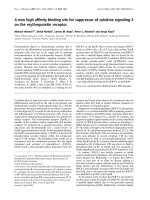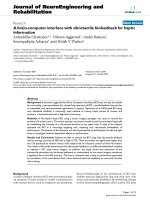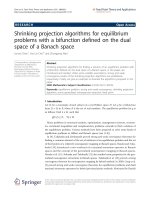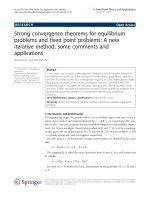A new iterative scheme with nonexpansive mapping for equilibrium problems 2012
Bạn đang xem bản rút gọn của tài liệu. Xem và tải ngay bản đầy đủ của tài liệu tại đây (303.55 KB, 11 trang )
PN and DD Journal of Inequalities and Applications 2012, 2012:116
/>
RESEARCH
Open Access
A new iterative scheme with nonexpansive
mappings for equilibrium problems
Anh PN1* and Thanh DD2
* Correspondence:
vn
1
Department of Scientific
Fundamentals, Posts and
Telecommunications Institute of
Technology, Hanoi, Vietnam
Full list of author information is
available at the end of the article
Abstract
In this paper, we suggest a new iteration scheme for finding a common of the
solution set of monotone, Lipschitz-type continuous equilibrium problems and the
set of fixed points of a nonexpansive mapping. The scheme is based on both hybrid
method and extragradient-type method. We obtain a strong convergence theorem
for the sequences generated by these processes in a real Hilbert space. Based on this
result, we also get some new and interesting results. The results in this paper
generalize, extend, and improve some well-known results in the literature.
AMS 2010 Mathematics subject classification: 65 K10, 65 K15, 90 C25, 90 C33.
Keywords: Equilibrium problems, nonexpansive mappings, monotone, Lipschitz-type
continuous, fixed point
1 Introduction
Let H be a real Hilbert space with inner product 〈·,·〉 and norm || · ||. Let C be a nonempty closed convex subset of a real Hilbert space H. A mapping S : C ® C is a
contraction with a constant δ Î (0, 1), if
||S(x) − S(y)|| ≤ δ||x − y||, ∀x, y ∈ C.
If δ = 1, then S is called nonexpansive on C. Fix(S) is denoted by the set of fixed
points of S. Let f : C × C → R be a bifunction such that f(x, x) = 0 for all x Î C. We
consider the equilibrium problem in the sense of Blum and Oettli (see [1]) which is
presented as follows:
Find x∗ ∈ C such that f (x∗ , y) ≥ 0 for all y ∈ C.
EP(f , C)
The set of solutions of EP(f, C) is denoted by Sol(f, C). The bifunction f is called
strongly monotone on C with ß > 0, if
f (x, y) + f (y, x) ≤ −β||x − y||2 , ∀x, y ∈ C;
monotone on C, if
f (x, y) + f (y, x) ≤ 0, ∀x, y ∈ C;
pseudomonotone on C, if
f (x, y) ≥ 0 implies f (y, x) ≤ 0, ∀x, y ∈ C;
© 2012 PN and DD; licensee Springer. This is an Open Access article distributed under the terms of the Creative Commons Attribution
License ( which permits unrestricted use, distribution, and reproduction in any medium,
provided the original work is properly cited.
PN and DD Journal of Inequalities and Applications 2012, 2012:116
/>
Page 2 of 11
Lipschitz-type continuous on C with constants c1 >0 and c2 >0 (see [2]), if
f (x, y) + f (y, z) ≥ f (x, z) − c1 ||x − y||2 − c2 ||y − z||2 , ∀x, y, z ∈ C.
It is well-known that Problem EP(f, C) includes, as particular cases, the optimization
problem, the variational inequality problem, the Nash equilibrium problem in noncooperative games, the fixed point problem, the nonlinear complementarity problem and
the vector minimization problem (see [2-6]).
In recent years, the problem to find a common point of the solution set of problem
(EP) and the set of fixed points of a nonexpansive mapping becomes an attractive field
for many researchers (see [7-15]). An important special case of equilibrium problems
is the variational inequalities (shortly (VIP)), where F : C ® H and f(x, y) = 〈F(x), y x〉. Various methods have been developed for finding a common point of the solution
set of problem (VIP) and the set of fixed points of a nonexpansive mapping when F is
monotone (see [16-18]).
Motivated by fixed point techniques of Takahashi and Takahashi in [19] and an
improvement set of extragradient-type iteration methods in [20], we introduce a new
iteration algorithm for finding a common of the solution set of equilibrium problems
with a monotone and Lipschitz-type continuous bifunction and the set of fixed points of
a nonexpansive mapping. We show that all of the iterative sequences generated by this
algorithm convergence strongly to the common element in a real Hilbert space.
2 Preliminaries
Let C be a nonempty closed convex subset of a Hilbert space H. We write xn ⇀ x to
indicate that the sequence {xn} converges weakly to x as n ® ∞, xn ® x implies that
{xn} converges strongly to x. For any x Î H, there exists a nearest point in C, denoted
by PrC(x), such that
||x − PrC (x)|| ≤ ||x − y||, ∀y ∈ C.
PrC is called the metric projection of H to C. It is well known that PrC satisfies the
following properties:
x − y, PrC (x) − PrC (y) ≥ ||PrC (x) − PrC (y)||2 , ∀x, y ∈ H,
(2:1)
x − PrC (x), PrC (x) − y > ≥ 0, ∀x ∈ H, y ∈ C,
(2:2)
||x − y||2 ≥ ||x − PrC (x)||2 + ||y − PrC (x)||2 , ∀x ∈ H, y ∈ C.
(2:3)
Let us assume that a bifunction f : C × C → R and a nonexpansive mapping S : C ®
C satisfy the following conditions:
A1. f is Lipschitz-type continuous on C;
A2. f is monotone on C;
A3. for each x Î C, f (x, ·) is subdifferentiable and convex on C;
A4. Fix(S) ∩ Sol(f, C) ≠ ∅.
Recently, Takahashi and Takahashi in [19] first introduced an iterative scheme by the
viscosity approximation method. The sequence {xk} is defined by:
PN and DD Journal of Inequalities and Applications 2012, 2012:116
/>
⎧ 0
⎨ x ∈ H,
Find uk ∈ C such that f (uk , y) + r1k y − uk , uk − xk ≥ 0,
⎩ k+1
x = αk g(xk ) + (1 − αk )S(uk ), ∀k ≥ 0,
Page 3 of 11
∀y ∈ C,
where C is a nonempty closed convex subset of H and g is a contractive mapping of
H into itself. The authors showed that under certain conditions over {ak} and {rk},
sequences {xk} and {uk} converge strongly to z = PrSol(f,C)∩Fix(S) (g(x0)). Recently, iterative
methods for finding a common element of the set of solutions of equilibrium problems
and the set of fixed points of a nonexpansive mapping have further developed by many
authors. These methods require to solve approximation auxilary equilibrium problems.
In this paper, we introduce a new iteration method for finding a common point of
the set of fixed points of a nonexpansive mapping S and the set of solutions of problem EP(f, C). At each our iteration, the main steps are to solve two strongly convex
problems
yk = argmin {λk f (xk , y) + 12 ||y − xk ||2 : y ∈ C},
tk = argmin {λk f (yk , y) + 12 ||y − xk ||2 : y ∈ C},
(2:4)
and compute the next iteration point by Mann-type fixed points
xk+1 = αk g(xk ) + (1 − αk )S(tk ),
(2:5)
where g : C ® C is a δ-contraction with 0 < δ < 12.
To investigate the convergence of this scheme, we recall the following technical lemmas which will be used in the sequel.
Lemma 2.1 (see [21]) Let {an} be a sequence of nonnegative real numbers such that:
an+1 ≤ (1 − αn )an + βn , n ≥ 0,
where {an}, and {ßn} satisfy the conditions:
∞
αn = ∞;
(i) an ⊂ (0, 1) and
n=1
(ii) lim sup
n→∞
βn
αn
∞
≤ 0 or
|βn | < ∞.
n=1
Then
lim an = 0.
n→∞
Lemma 2.2 ([22]) Assume that S is a nonexpansive self-mapping of a nonempty
closed convex subset C of a real Hilbert space H. If Fix(S) ≠ Ø, then I - S is demiclosed;
that is, whenever {x k } is a sequence in C weakly converging to some x¯ ∈ C and the
sequence {(I - S)(xk)} strongly converges to some y¯ , it follows that (I − S)(¯x) = y¯ . Here I is
the identity operator of H.
Lemma 2.3 (see [20], Lemma 3.1) Let C be a nonempty closed convex subset of a real
Hilbert space H. Let f : C × C → Rbe a pseudomonotone, Lipschitz-type continuous
bifunction with constants c1 >0 and c2 >0. For each × Î C, let f(x, ·) be convex and
subdifferentiable on C. Suppose that the sequences {xk}, {yk}, {tk} generated by Scheme
(2.4) and x* Î Sol(f, C). Then
||tk − x∗ ||2 ≤ ||xk − x∗ ||2 − (1 − 2λk c1 )||xk − yk ||2 − (1 − 2λk c2 )||yk − tk ||2 , ∀k ≥ 0.
PN and DD Journal of Inequalities and Applications 2012, 2012:116
/>
Page 4 of 11
3 Main results
Now, we prove the main convergence theorem.
Theorem 3.1 Suppose that Assumptions A1-A4 are satisfied, x0 Î C and two positive
sequences {lk}, {ak} satisfy the following restrictions:
⎧∞
⎪
⎪
|αk+1 − αk | < ∞,
⎪
⎪
⎪
k=0
⎪
⎪
⎪ lim αk = 0,
⎪
⎪
⎪
⎪ k→∞
∞
⎨
αk = ∞,
⎪
k=0
⎪
∞
⎪
√
⎪
⎪
⎪
|λk+1 − λk | < ∞,
⎪
⎪
⎪
k=0
⎪
⎪
⎪
⎩ {λ } ⊂ [a, b] for some a, b ∈ (0, 1 ), where L = max{2c , 2c }.
k
1
2
L
Then the sequences {xk}, {yk} and {tk} generated by (2.4) and (2.5) converge strongly to
the same point x*, where
x∗ = PrFix(S)∩Sol(f ,C) g(x∗ ).
The proof of this theorem is divided into several steps.
Step 1. Claim that
lim ||xk − tk || = 0.
k→∞
Proof of Step 1. For each x* Î Fix(S) ∩ Sol(f, C), it follows from xk+1 = akg(xk) + (1 ak)S(tk), Lemma 2.3 and δ ∈ (0, 12 ) that
||xk+1 − x∗ ||2 = ||αk (g(xk ) − x∗ ) + (1 − αk )(S(tk ) − S(x∗ ))||2
≤ αk ||g(xk ) − x∗ ||2 + (1 − αk )||S(tk ) − S(x∗ )||2
= αk ||(g(xk ) − g(x∗ )) + (g(x∗ ) − x∗ )||2 + (1 − αk )||S(tk ) − S(x∗ )||2
≤ 2δ 2 αk ||xk − x∗ ||2 + 2αk ||g(x∗ ) − x∗ ||2 + (1 − αk )||tk − x∗ ||2
≤ 2δ 2 αk ||xk − x∗ ||2 + 2αk ||g(x∗ ) − x∗ ||2 + (1 − αk )||xk − x∗ ||2
− (1 − αk )(1 − 2λk c1 )||xk − yk ||2 − (1 − αk )(1 − 2λk c2 )||yk − tk ||2
≤ ||xk − x∗ ||2 + 2αk ||g(x∗ ) − x∗ ||2 − (1 − αk )(1 − 2λk c1 )||xk − yk ||2
− (1 − αk )(1 − 2λk c2 )||yk − tk ||2 .
Then, we have
(1 − αk )(1 − 2bc1 )||xk − yk ||2 ≤ (1 − αk )(1 − 2λk c1 )||xk − yk ||2
≤ ||xk − x∗ ||2 − ||xk+1 − x∗ ||2 + 2αk ||g(x∗ ) − x∗ ||2
→ 0 as k → ∞,
and
lim ||xk − yk || = 0.
k→∞
By the similar way, also
lim ||yk − tk || = 0.
k→∞
(3:1)
PN and DD Journal of Inequalities and Applications 2012, 2012:116
/>
Page 5 of 11
Combining this, (3.1) and the inequality ||xk - tk|| = ||xk - yk || + || yk - tk ||, we have
lim ||xk − tk || = 0.
(3:2)
k→∞
Step 2. Claim that
lim ||xk+1 − xk || = 0.
k→∞
Proof of Step 2. It is easy to see that tk = argmin { 12 ||t − xk ||2 + λk f (yk , t) : t ∈ C} if
and only if
0 ∈ ∂2 (λk f (yk , y) + 12 ||y − xk ||2 )(tk ) + NC (tk ),
where N C (x) is the (outward) normal cone of C at x Î C. This means that
k
k
0 = λk w + tk − xk + w¯ , where w Î ∂ 2 f(y , t ) and w¯ ∈ NC (tk ). By the definition of the
normal cone NC we have, from this relation that
tk − xk , t − tk ≥ λk w, tk − t ∀t ∈ C.
Substituting t = tk+1 into this inequality, we get
tk − xk , tk+1 − tk ≥ λk w, tk − tk+1 .
(3:3)
Since f(x, ·) is convex on C for all x Î C, we have
f (yk , t) − f (yk , tk ) ≥ w, t − tk ∀t ∈ C, w ∈ ∂2 f (yk , tk ).
Using this and (3.3), we have
tk − xk , tk+1 − tk ≥ λk w, tk − tk+1
≥ λk (f (yk , tk ) − f (yk , tk+1 )).
(3:4)
By the similar way, we also have
tk+1 − xk+1 , tk − tk+1 ≥ λk+1 (f (yk+1 , tk+1 ) − f (yk+1 , tk )).
(3:5)
Using (3.4), (3.5) and f is Lipschitz-type continuous and monotone, we get
1
1 k+1
||x − xk ||2 − ||tk+1 − tk ||2
2
2
≥ tk+1 − tk , tk − xk − tk+1 + xk+1
≥ λk (f (yk , tk ) − f (yk , tk+1 ))
+ λk+1 (f (yk+1 , tk+1 ) − f (yk+1 , tk ))
≥ λk (−f (tk , tk+1 ) − c1 ||yk − tk ||2 − c2 ||tk − tk+1 ||2 )
+ λk+1 (−f (tk+1 , tk ) − c1 ||yk+1 − tk+1 ||2 − c2 ||tk − tk+1 ||2 )
≥ (λk+1 − λk )f (tk , tk+1 )
≥ −|λk+1 − λk ||f (tk , tk+1 )|.
Hence
||tk+1 − tk || ≤
||xk+1 − xk ||2 + 2|λk+1 − λk ||f (tk , tk+1 )|
≤ ||xk+1 − xk || +
2|λk+1 − λk ||f (tk , tk+1 )|
(3:6)
PN and DD Journal of Inequalities and Applications 2012, 2012:116
/>
Page 6 of 11
Since (3.6), ak+1 - ak ® 0 as k ®∞, g is contractive on C, Lemma 2.3, Step 2 and the
definition of xk+1 that xk+1 = akg(xk) + akS(tk), we have
||xk+1 − xk || = ||αk g(xk ) + αk S(tk ) − αk−1 g(xk−1 ) − αk−1 S(tk−1 )||
= ||(αk − αk−1 )(g(xk−1 ) − S(tk−1 )) + (1 − αk )(S(tk ) − S(tk−1 ))
+ αk (g(xk ) − g(xk−1 ))||
≤ |αk − αk−1 |||g(xk−1 ) − S(tk−1 )|| + (1 − αk )||tk − tk−1 || + αk δ||xk − xk−1 ||
≤ |αk − αk−1 |||g(xk−1 ) − S(tk−1 )|| + (1 − αk )(||xk − xk−1 ||
+
2|λk − λk−1 ||f (tk−1 , tk )|) + αk δ||xk − xk−1 ||
= (1 − (1 − δ)αk )||xk − xk−1 || + |αk − αk−1 |||g(xk−1 ) − S(tk−1 )||
+ (1 − αk ) 2|λk − λk−1 ||f (tk−1 , tk )|
≤ (1 − (1 − δ)αk )||xk − xk−1 || + M|αk − αk−1 | + K(1 − αk ) 2|λk − λk−1 |,
where δ is contractive constant of the mapping g, M = sup{||g(xk
- 1
) - S(tk
- 1
)||: k =
∞
0, 1, ...} and K = sup
|αk − αk−1 | < ∞ and
|f (tk−1 , tk )| : k = 0, 1, · · · , since
k=0
∞
|λk − λk−1 | < ∞, in view of Lemma 2.1, we have lim ||xk+1 − xk || = 0.
k→∞
k=0
Step 3. Claim that
lim ||tk − S(tk )|| = 0.
k→∞
Proof of Step 3. From xk+1 = akg(xk) + (1 - ak)S(tk), we have
xk+1 − xk = αk g(xk ) + (1 − αk )S(tk ) − xk
= αk (g(xk ) − xk ) + (1 − αk )(tk − xk ) + (1 − αk )(S(tk ) − tk )
and hence
(1 − αk )||S(tk ) − tk || ≤ ||xk+1 − xk || + αk ||g(xk ) − xk || + (1 − αk )|| tk − xk ||.
lim αk = 0, Step 1 and Step 2, we have
Using this, k→∞
lim ||tk − S(tk )|| = 0.
k→∞
Step 4. Claim that
lim sup x∗ − g(x∗ ), S(tk ) − x∗ ≥ 0.
k→∞
Proof of Step 4. By Step 1, {tk} is bounded, there exists a subsequence {tki } of {tk} such
that
lim sup x∗ − g(x∗ ), tk − x∗ = lim x∗ − g(x∗ ), tki − x∗ .
k→∞
i→∞
Since the sequence {tki } is bounded, there exists a subsequence {tkij } of {tki } which
converges weakly to t¯. Without loss of generality we suppose that the sequence {tki }
converges weakly to ¯t such that
PN and DD Journal of Inequalities and Applications 2012, 2012:116
/>
Page 7 of 11
lim sup x∗ − g(x∗ ), tk − x∗ = lim x∗ − g(x∗ ), tki − x∗ .
i→∞
k→∞
(3:7)
Since Lemma 2.2 and Step 3, we have
S(¯t) = ¯t ⇔ ¯t ∈ Fix(S).
(3:8)
Now we show that ¯t ∈ Sol(f , C). By Step 1, we also have
¯t , yki
xk i
¯t.
Since yk is the unique solution of the strongly convex problem
min{ 12 ||y − xk ||2 + f (xk , y) : y ∈ C},
we have
0 ∈ ∂2 (λk f (xk , y) +
1
||y − xk ||2 )(yk ) + NC (yk ).
2
This follows that
0 = λk w + yk − xk + wk ,
where w Î ∂2f (xk, yk) and wk Î NC(yk). By the definition of the normal cone NC, we
have
yk − xk , y − yk ≥ λk w, yk − y , ∀y ∈ C.
(3:9)
On the other hand, since f(xk, ·) is subdifferentiable on C, by the well-known Moreau-Rockafellar theorem, there exists w Î ∂2f(xk, yk) such that
f (xk , y) − f (xk , yk ) ≥ w, y − yk , ∀y ∈ C.
Combining this with (3.9), we have
λk (f (xk , y) − f (xk , yk )) ≥ yk − xk , yk − y , ∀y ∈ C.
Hence
λkj (f (xkj , y) − f (xkj , ykj )) ≥ ykj − xkj , ykj − y ,
∀y ∈ C.
Then, using {λk } ⊂ [a, b] ⊂ (0, 1L ) and the continuity of f , we have
f (t¯, y) ≥ 0, ∀y ∈ C.
Combining this and (3.8), we obtain
t ki
¯t ∈ Fix(S) ∩ Sol(f , C).
By (3.7) and the definition of x*, we have
lim sup x∗ − g(x∗ ), tk − x∗ = x∗ − g(x∗ ), ¯t − x∗ ≥ 0.
k→∞
Using this and Step 3, we get
lim sup x∗ − g(x∗ ), S(tk ) − x∗ = x∗ − g(x∗ ), ¯t − x∗ ≥ 0.
k→∞
Step 5. Claim that the sequences {xk}, {yk} and {tk} converge strongly to x*.
PN and DD Journal of Inequalities and Applications 2012, 2012:116
/>
Page 8 of 11
Proof of Step 5. Using xk+1 = akg(xk) + (1 - ak)S(tk) and Lemma 2.3, we have
||xk+1 − x∗ ||2 = ||αk (g(xk ) − x∗ ) + (1 − αk )(S(tk ) − x∗ )||2
= αk2 ||g(xk ) − x∗ ||2 + (1 − αk )2 ||S(tk ) − x∗ ||2
+ 2αk (1 − αk ) g(xk ) − x∗ , S(tk ) − x∗
≤ αk2 ||g(xk ) − x∗ ||2 + (1 − αk )2 ||xk − x∗ ||2
+ 2αk (1 − αk ) g(xk ) − x∗ , S(tk ) − x∗
= αk2 ||g(xk ) − x∗ ||2 + (1 − αk )2 ||xk − x∗ ||2
+ 2αk (1 − αk ) g(xk ) − g(x∗ ), S(tk ) − x∗
+ 2αk (1 − αk ) g(x∗ ) − x∗ , S(tk ) − x∗
≤ αk2 ||g(xk ) − x∗ ||2 + (1 − αk )2 ||xk − x∗ ||2
+ 2δαk (1 − αk )||xk − x∗ ||||(tk ) − x∗ ||
+ 2αk (1 − αk ) g(x∗ ) − x∗ , S(tk ) − x∗
≤ αk2 ||g(xk ) − x∗ ||2 + ((1 − αk )2 + 2δαk (1 − αk ))||xk − x∗ ||2
+ 2αk (1 − αk ) g(x∗ ) − x∗ , S(tk ) − x∗
≤ (1 − αk + 2δαk )||xk − x∗ ||2 + αk2 ||g(xk ) − x∗ ||2
+ 2αk (1 − αk ) max{0, g(x∗ ) − x∗ , S(tk ) − x∗ }
= (1 − Ak )||xk − x∗ ||2 + Bk ,
where Ak and Bk are defined by
Ak = αk (1 − 2δ),
Bk = αk2 ||g(xk ) − x∗ ||2 + 2αk (1 − αk ) max{0, g(x∗ ) − x∗ , S(tk ) − x∗ }.
∞
Since lim αk = 0,
k→∞
∗
∗
k
∗
αk = ∞, Step 4, we have lim sup x − g(x ), S(t ) − x ≥ 0 and
k→∞
k=1
hence
Bk = o(Ak ), lim Ak = 0,
k→∞
∞
Ak = ∞.
k=1
By Lemma 2.1, we obtain that the sequence {xk} converges strongly to x*. It follows
from Step 1 that the sequences {yk} and {tk} also converge strongly to the same solution x*= PrFix(S)∩Sol(f,C)g(x*).
□
4 Applications
Let C be a nonempty closed convex subset of a real Hilbert space H and F be a function from C into H. In this section, we consider the variational inequality problem
which is presented as follows:
Find x∗ ∈ C such that F(x∗ ), x − x∗ ≥ 0 for all x ∈ C.
VI(F, C)
Let f : C × C → R be defined by f(x, y) = 〈F(x), y - x〉. Then Problem EP(f, C) can be
written in VI(F, C). The set of solutions of VI(F, C) is denoted by Sol(F, C). Recall that
the function F is called strongly monotone on C with ß >0 if
F(x) − F(y), x − y ≥ β||x − y||2 , ∀x, y ∈ C;
PN and DD Journal of Inequalities and Applications 2012, 2012:116
/>
Page 9 of 11
monotone on C if
F(x) − F(y), x − y ≥ 0, ∀x, y ∈ C;
pseudomonotone on C if
F(y), x − y ≥ 0 ⇒ F(x), x − y ≥ 0, ∀x, y ∈ C;
Lipschitz continuous on C with constants L >0 if
||F(x) − F(y)|| ≤ L||x − y||, ∀x, y ∈ C.
Since
1
||y − xk ||2 : y ∈ C}
2
1
= argmin {λk F(xk ), y − xk + ||y − xk ||2 : y ∈ C}
2
= PrC (xk − λk F(xk )),
yk = argmin{λk f (xk , y) +
(2.4), (2.5) and Theorem 3.1, we obtain that the following convergence theorem for
finding a common element of the set of fixed points of a nonexpansive mapping S and
the solution set of problem VI(F, C).
Theorem 4.1 Let C be a nonempty closed convex subset of a real Hilbert space H, F
be a function from C to Hsuch that F is monotone and L-Lipschitz continuous on C, g :
C ® C is contractive with constant δ ∈ (0,
1
2 ),
S: C ® C be nonexpansive and positive
sequences {ak} and {lk} satisfy the following restrictions
⎧∞
⎪
⎪
|αk+1 − αk | < ∞,
⎪
⎪
⎪
k=0
⎪
⎪
⎪
lim αk = 0,
⎪
⎪
⎪
⎨ k→∞
∞
αk = ∞,
⎪
⎪
k=0
⎪
⎪
∞
⎪ √
⎪
⎪
|λk+1 − λk | < ∞,
⎪
⎪
⎪
⎪
⎩ k=0
{λk } ⊂ [a, b] for some a, b ∈ (0,
1
L ).
Then sequences {xk}, {yk} and {tk} generated by
⎧ k
⎨ y = PrC (xk − λk F(xk )),
tk = Pr (xk − λk F(yk )),
⎩ k+1 C
x = αk g(xk ) + (1 − αk )S(tk ),
converge strongly to the same point x* Î PrFix(S)∩Sol(F,C)g(x*).
Thus, this scheme and its convergence become results proposed by Nadezhkina and
Takahashi in [23]. As direct consequences of Theorem 3.1, we obtain the following
corollary.
Corollary 4.2 Suppose that Assumptions A1-A3 are satisfied, Sol(f, C) ≠ Ø, x0 Î C
and two positive sequences {lk}, {ak} satisfy the following restrictions:
PN and DD Journal of Inequalities and Applications 2012, 2012:116
/>
⎧∞
⎪
⎪
|αk+1 − αk | < ∞,
⎪
⎪
⎪
k=0
⎪
⎪
⎪
lim αk = 0,
⎪
⎪
⎪
⎨ k→∞
∞
αk = ∞,
⎪
⎪
k=0
⎪
⎪
⎪∞√
⎪
⎪
|λk+1 − λk | < ∞,
⎪
⎪
⎪
k=0
⎪
⎩
{λk } ⊂ [a, b] for some a, b ∈ (0,
1
L ),
Page 10 of 11
where L = max{2c1 , 2c2 }.
Then, the sequences {xk}, {yk} and {tk} generated by
⎧ k
⎨ y = argmin {λk f (xk , y) + 12 ||y − xk ||2 : y ∈ C},
tk = argmin {λk f (yk , y) + 12 ||y − xk ||2 : y ∈ C}
⎩ k+1
x = αk g(xk ) + (1 − αk )tk ,
where g : C ® C is a δ-contraction with 0 < δ < 12, converge strongly to the same
point x*=PrSol(f,C)g(x*).
Acknowledgements
We are very grateful to the anonymous referees for their really helpful and constructive comments that helped us
very much in improving the paper.
The work was supported by National Foundation for Science and Technology Development of Vietnam (NAFOSTED).
Author details
1
Department of Scientific Fundamentals, Posts and Telecommunications Institute of Technology, Hanoi, Vietnam
2
Department of Mathematics, Haiphong university, Vietnam
Authors’ contributions
The main idea of this paper is proposed by P.N. Anh. The revision is made by DDT. PNA and DDT prepared the
manuscript initially and performed all the steps of proof in this research. All authors read and approved the final
manuscript.
Competing interests
The authors declare that they have no competing interests.
Received: 5 December 2011 Accepted: 28 May 2012 Published: 28 May 2012
References
1. Blum, E, Oettli, W: From optimization and variational inequality to equilibrium problems. The Math Stud. 63, 127–149
(1994)
2. Mastroeni, G: On auxiliary principle for equilibrium problems. In: Daniele P, Giannessi F, Maugeri A (eds.) Nonconvex
Optimization and its Applications. Kluwer Academic Publishers, Dordrecht, The Netherlands (2003)
3. Anh, PN: A logarithmic quadratic regularization method for solving pseudomonotone equilibrium problems. Acta Math
Vietnamica. 34, 183–200 (2009)
4. Anh, PN: An LQP regularization method for equilibrium problems on polyhedral. Vietnam J Math. 36, 209–228 (2008)
5. Anh, PN, Kim, JK: Outer approximation algorithms for pseudomonotone equilibrium problems. Comp Math Appl. 61,
2588–2595 (2011). doi:10.1016/j.camwa.2011.02.052
6. Quoc, TD, Anh, PN, Muu, LD: Dual extragradient algorithms to equilibrium Problems. J Glob Optim. 52, 139–159 (2012).
doi:10.1007/s10898-011-9693-2
7. Anh, PN: Strong convergence theorems for nonexpansive mappings and Ky Fan inequalities. J Optim Theory Appl
(2012). DOI 10.1007/s10957-012-0005-x
8. Anh, PN, Kim, JK, Nam, JM: Strong convergence of an extragradient method for equilibrium problems and fixed point
problems. J Korean Math Soc. 49, 187–200 (2012). doi:10.4134/JKMS.2012.49.1.187
9. Anh, PN, Son, DX: A new iterative scheme for pseudomonotone equilibrium problems and a finite family of
pseudocontractions. J Appl Math Inform. 29, 1179–1191 (2011)
10. Ceng, LC, Schaible, S, Yao, JC: Implicit iteration scheme with perturbed mapping for equilibrium problems and fixed
point problems of finitely many nonexpansive mappings. J Optim Theory Appl. 139, 403–418 (2008). doi:10.1007/
s10957-008-9361-y
11. Chen, R, Shen, X, Cui, S: Weak and strong convergence theorems for equilibrium problems and countable strict
pseudocontractions mappings in Hilbert space. J Ineq Appl (2010). DOI:10.1155/2010/474813
12. Wang, S, Cho, YJ, Qin, X: A new iterative method for solving equilibrium problems and fixed point problems for an
infinite family of nonexpansive mappings. Fix Point Theory Appl (2010). DOI: 10.1155/2010/165098
13. Wangkeeree, R: An extragradient approximation method for equilibrium problems and fixed point problems of a
countable family of nonexpansive mappings. Fix Point Theory Appl (2008). DOI:10.1155/2008/134148
PN and DD Journal of Inequalities and Applications 2012, 2012:116
/>
14. Yao, Y, Liou, YC, Jao, JC: Convergence theorem for equilibrium problems and fixed point problems of infinite family of
nonexpansive mappings. Fix Point Theory Appl (2007). DOI:10.1155/2007/64363
15. Yao, Y, Liou, YC, Wu, YJ: An extragradient method for mixed equilibrium problems and fixed point problems. Fix Point
Theory Appl (2009). DOI: 10.1155/2009/632819
16. Ceng, LC, Petrusel, A, Lee, C, Wong, MM: Two extragradient approximation methods for variational inequalities and
fixed point problems of strict pseudo-contractions. Taiwanese J Math. 13, 607–632 (2009)
17. Takahashi, S, Toyoda, M: Weakly convergence theorems for nonexpansive mappings and monotone mappings. J Optim
Theory Appl. 118, 417–428 (2003). doi:10.1023/A:1025407607560
18. Zeng, LC, Yao, JC: Strong convergence theorem by an extragradient method for fixed point problems and variational
inequality problems. Taiwanese J Math. 10, 1293–1303 (2010)
19. Takahashi, S, Takahashi, W: Viscosity approximation methods for equilibrium problems and fixed point problems in
Hilbert spaces. J Math Anal Appl. 331, 506–515 (2007). doi:10.1016/j.jmaa.2006.08.036
20. Anh, PN: A hybrid extragradient method extended to fixed point problems and equilibrium problems. Optimization
(2012). DOI:10.1080/02331934.2011.607497
21. Xu, HK: Viscosity approximation methods for nonexpansive mappings. J Math Anal Appl. 298, 279–291 (2004).
doi:10.1016/j.jmaa.2004.04.059
22. Goebel, K, Kirk, WA: Topics on metric fixed point theory. Cambridge University Press, Cambridge, England (1990)
23. Nadezhkina, N, Takahashi, W: Weak convergence theorem by an extragradient method for nonexpansive mappings and
monotone mappings. J Optim Theory Appl. 128, 191–201 (2006). doi:10.1007/s10957-005-7564-z
doi:10.1186/1029-242X-2012-116
Cite this article as: PN and DD: A new iterative scheme with nonexpansive mappings for equilibrium problems.
Journal of Inequalities and Applications 2012 2012:116.
Submit your manuscript to a
journal and benefit from:
7 Convenient online submission
7 Rigorous peer review
7 Immediate publication on acceptance
7 Open access: articles freely available online
7 High visibility within the field
7 Retaining the copyright to your article
Submit your next manuscript at 7 springeropen.com
Page 11 of 11









